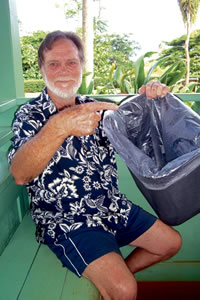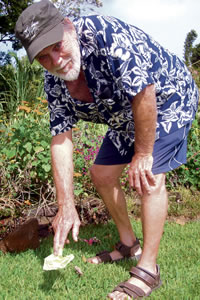Cleaning Up On ‘The Garbage Isle’
It’s not visitors who do the most damage to our island, but locals. So says Del Contival, adding litterers have a ‘social disease.’ Picking up after others has become his quest
It’s not the Garden Isle, it’s the Garbage Isle, according to Kalaheo resident Del Contival.
Heaps of rubbish strewn across roadways and tangled in foliage is something Contival is accustomed to seeing on his regular neighborhood walks.
Since moving to the island in 2008 with his wife, Kaua’i native Joan Fukunaga, whom he met in California, Contival developed the habit of walking most days of the week.
“It was either move it or lose it,” he says regarding why he chose to initiate the exercise routine.
While on his walking routes, however, he started noticing trash, trash and more trash.
“What I began to see out there embarrassed me and, secondly, saddened me,” he says.
Determined to do something about it, Contival purchased a tool so that he could easily grab the rubbish, and every time he left the house for a walk, he picked up other people’s discards and continues to do so to this day.
“You would be amazed at what I find out there,” he says.
Cigarette butts are primarily what Contival picks up, but the list of found items is long. He’s collected everything from alcohol containers and wallets (sans money) to hypodermic needles and diapers. What surprises him most is that it is kama’aina who are disrespecting the island and treating it like a garbage pit.
“It was a culture shock when I got over here to see this behavior,” says Contival, who moved here from a small, litter-free town in the San Bernardino Mountains near Big Bear in Southern California.
On any given walk, he fills as many as four 50-gallon bags with litter – and it takes only 24 hours before the area is trashed again.
“It’s constant,” he says. One spot in his neighborhood that particularly bothers Contival is near the Lawai Cannery.
“You can’t stand the stench,” he says of Lawai stream. “If you were to stop your car and look over the edge at that stream, it would make you vomit.”
The area is filled with many toxic household items such as refrigerators and stoves as well as rotten pig carcasses and car transmissions. Contival alone has picked up some 30 car batteries and 40 tires from the area.
“We’ve got a dump that is essentially free to everybody – that’s what I don’t understand,” he says. “Nobody quite makes it to the dump.”
What concerns the retired 72-year-old is that the items contaminate the waterways and eventually end up in the ocean.
“All this stuff migrates,” he says. “Nobody realizes this. This island should start paying attention to this.”
One person who has been paying attention to Contival’s selfless work is National Tropical Botanical Garden’s Rae Matthews.
“Del keeps extremely fit with his daily walking, but he also keeps Kalaheo looking beautiful for its residents and island visitors by picking up garbage on our streets,” she says.
When Matthews drives down Papalina Road during the workweek, she always challenges herself to find any opala remaining on the sides of the road after Contival has combed through the area.
“I most often see nothing,” she says.
Matthews sometimes spots him hard at work picking up garbage deep in Lawai Valley.
“He knows my car now and he always waves at me. I give him the thumbs-up thanks,” she says.
Contival hopes others who see him may become inspired to do the same or rethink the items they toss from their car windows or leave in the back of their pickup trucks for the wind to blow away.
“I would hope it opens up something inside of them that would stop them from tossing their trash on the road,” he says.
He also would love to see children educated on the importance of caring for the land and not littering.
“The older generations already are who they are and what they are. The youngsters don’t know yet, except they’re getting the ‘out-the-window’ attitude from their family,” says Contival, adding that he would be happy to volunteer his time teaching keiki about the sad discoveries he makes on his walks and their detriment to the island.
Though he doesn’t really know how to completely change what he calls a “social disease,” he is fully committed to doing as much as he can.
“That’s all I can do,” he says. “I wish there was more that I could do to be helpful in this regard, but I don’t know what it is.”





